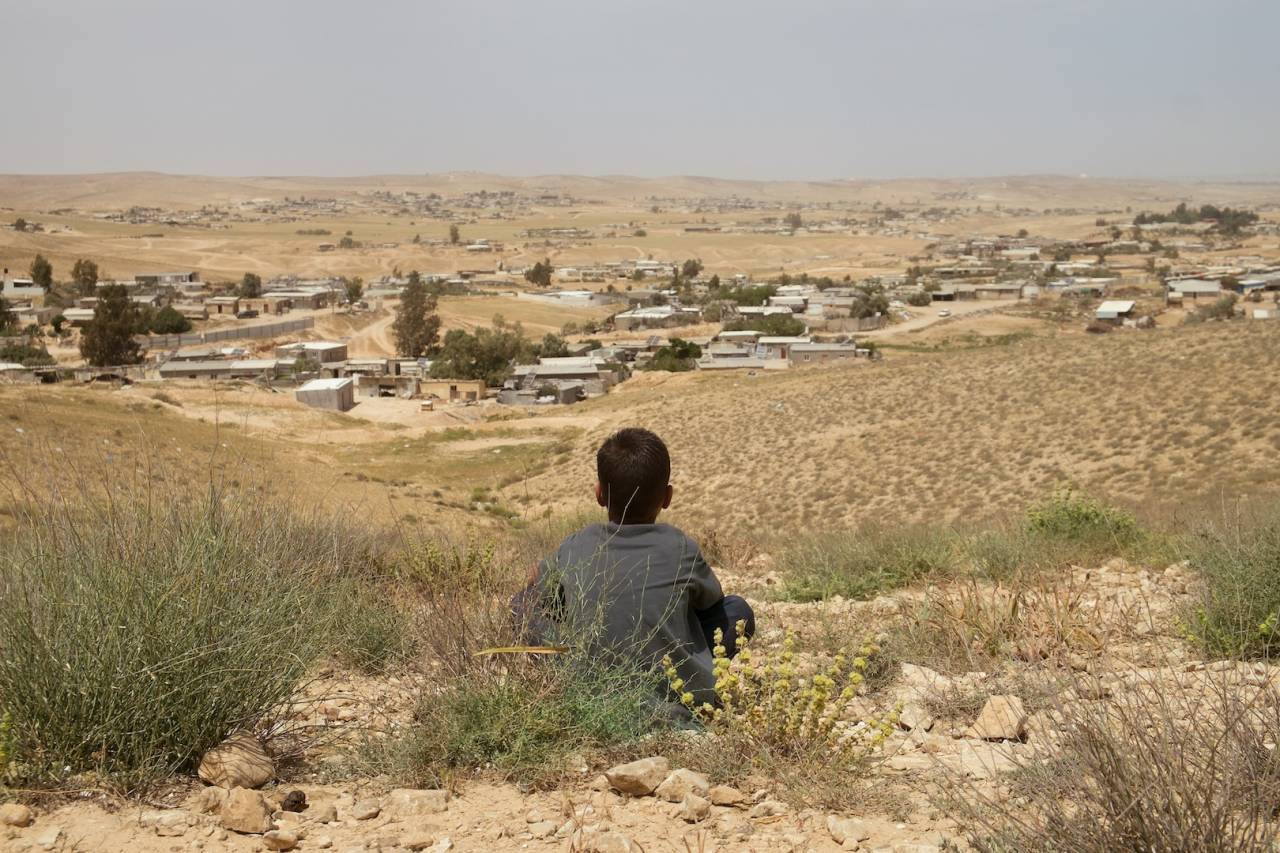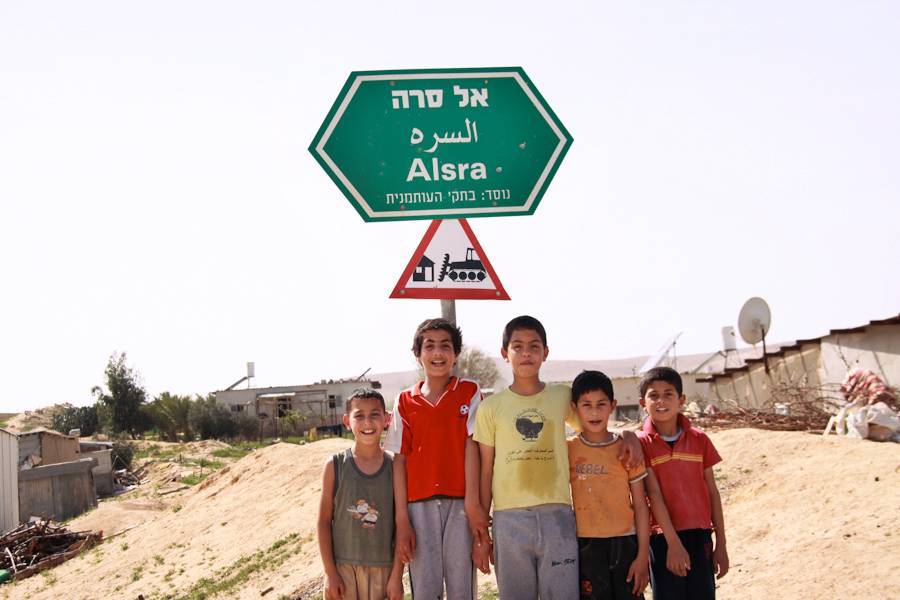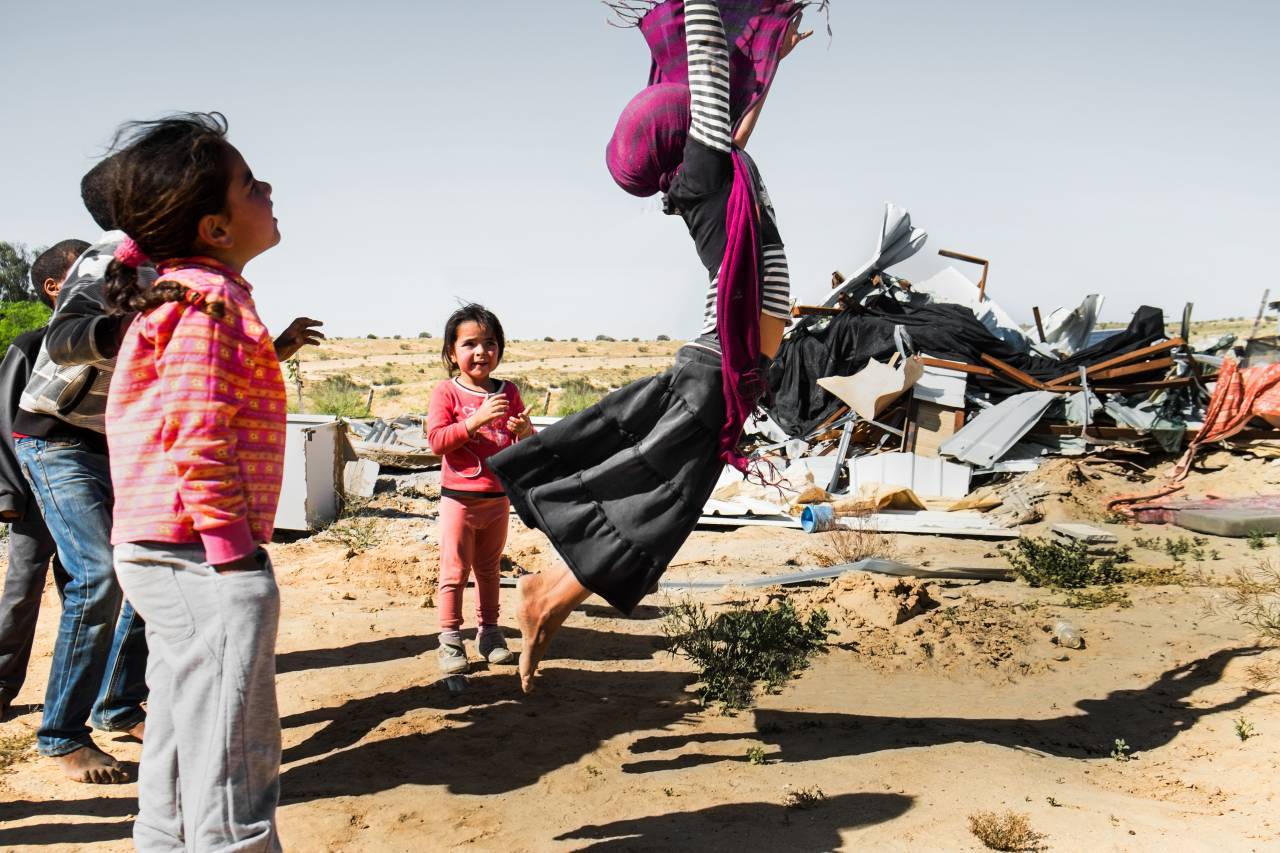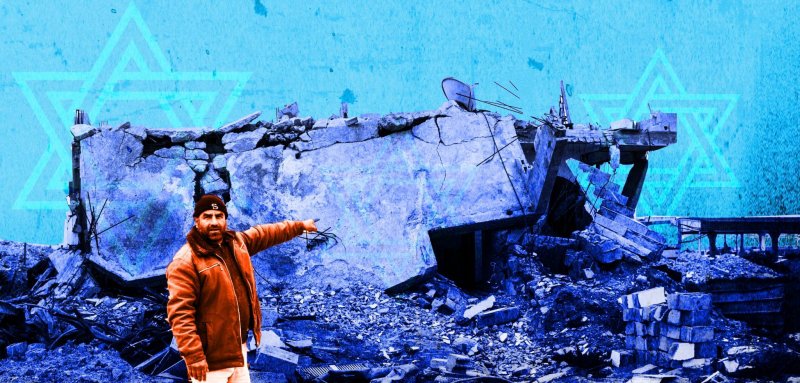More than 270,000 Palestinian Bedouins –holding Israeli citizenship – live in the Negev, the southernmost region of occupied Palestine, historically known as “Be'er Sheva” (or "Deirat Bir al-Sabe’").
As they descend into desert regions for leisure and exploration, visitors to the Negev can see how Arab villages are made up of tents and houses with zinc roofs. Many view this sight as strange; an entire community classified by Israeli statistics as the poorest in the country, for more than 60% of Negev Arabs live below the poverty line, according to reports by the National Insurance Institute of Israel (NII).
Many may find it strange or surprising how more than 150,000 "Israeli citizens" live under these tough circumstances, proving the false claim that Israel is the sole democracy in the Middle East and that its citizens enjoy equal rights and decent living.
But standing behind this poverty and suffering are clear motives where systematic Israeli plans aim to Judaize the Negev and strip its original Palestinian residents of their basic rights to the land. Foremost of these plans is how Israel completely refuses the recognition of 36 villages there. These unrecognized villages lack minimum basic infrastructure such as electricity, sanitation, medical services, schools and drinking water. Starting from lack of recognition, this region finds itself facing the “Blueprint Negev” development project among others… According to a home demolition report published by the Negev Coexistence Forum (NCF) in 2018, Israel demolished about 2,775 homes in the Negev within one year. And it seems that this saga is not coming to an end anytime soon.
Standing behind this poverty are clear motives where systematic Israeli plans aim to Judaize the Negev and strip its original Palestinian residents of their basic rights to the land
Demolition As Part Of Daily Life
In the “unrecognized” Negev village of al-Zarnouq, Muhammad Abu Qwaider greets his visitors with a smile. Every now and then the region welcomes foreign solidarity groups and Arab visitors from Palestinian villages north of the country, all interested in learning about the lives of the Bedouin people of the Negev and their struggle to preserve their rights in light of the racist Israeli policies directed against them. Muhammad Abu Qwaider tells these visitors about Bedouin customs, heritage, and hospitality, and recounts stories of equestrianism and resistance in the desert. He then takes them to see his house’s backyard. Overlooking a vast and beautiful desert valley, one can see young Arab men riding their horses and lone camels wandering across the landscape.
The Bedouin village of al-Zarnouq is threatened with the total displacement of its people and is subjected to systematic demolition campaigns as well as demolition orders and notices posted to its homes on a weekly basis. The villagers suffer from a lack of infrastructure; for there is no electricity, running water, a sewage system, or any modern facilities in the village. Residents depend on solar energy that they provide themselves and a water network they had put in place. They also pay three times as much as Jewish citizens do for water in neighboring villages.
On a road overlooking the al-Zarnouq valley, Muhammad Abu Qwaider points to the rubble of a house on the path and explains, "This is my older brother’s house. It was demolished three times. He was forced to live with his wife and children in our family home which is now also threatened with demolition." Then he points to a second house and adds, "This is the house of my brother Mahmoud Abu Qwaider, a political prisoner since 2013 who has been sentenced to 11 years in Israeli prisons. Currently residing in it is my brother Sameh Abu Qwaider, a freed prisoner after five years in captivity."

Photo by Mohammad Badarnah
Ongoing Military Rule & Nakba
The story of Negev Palestinians begins with racial discrimination during Palestine’s ‘Nakba’ (or Palestinian exodus) in 1948. Zionist gangs displaced nearly 90% of the Negev Arabs. Only 11,000 Arabs remained out of the original 95,000 in south Palestine. They were either deported to the Sinai, Jordan and Gaza, or killed in unrecorded Israeli massacres, fearfully recounted from verbal memory that has only been passed down from the narrations of their elderly.
The title of the post-Nakba phase across all of Palestine’s historical regions can only be described as "military rule", the period in which more than 95% of Negev lands were confiscated through the "Absentees' Property Law", which authorizes Israel to take possession of all non-inhabited land or property. By force of arms, the remaining residents were crammed into less than 4% of their rightful lands.
Throughout these decades, Israel developed instruments of demolition and pumped hundreds of millions of dollars into establishments, including the ‘Authority for Development and Settlement of the Bedouin in the Negev’ which is responsible for all that is related to implementing Israel’s vision in the region. It is through this establishment that home demolitions are carried out, as well as the planning of the displacement of Arab villages and negotiations with the Bedouins.
This authority also has its own private military police unit called the “Yoav” Police Unit. It was named after the military campaign that occupied the city of Beersheba (“Be'er Sheva”) in 1948. Hence, Negev Bedouins see the ‘Authority for Development and Settlement of the Bedouin in the Negev’ as an “ongoing military rule in the Negev."
The story of Negev Palestinians begins with racial discrimination during Palestine’s ‘Nakba’ in 1948. Zionist gangs displaced nearly 90% of the Negev Arabs. Only 11,000 Arabs remained out of the original 95,000 in south Palestine.
Pay For The Demolition Of Your Own Home
Israel pursued Ali al-Qar’an from western Negev and turned his life into a living hell for years, with the “Yoav” Police Unit destroying his home no less than three times. “After rebuilding it for the fourth time, the unit bulldozed then loaded the rubble of my house onto trucks. It also demolished the barn and confiscated forty heads of cattle, which were all my wealth," al- Qar’an told Raseef22.
He adds, “When I went to the authorities to reclaim my cattle, the ‘Society for the Protection of Nature in Israel’ demanded that I pay 60,000 Israeli shekels (equivalent to $17,800), and the authority’s personnel informed me that four cattle heads had died. Then the ‘Negev Development Authority’ asked me to pay another 70,000 shekels (about $ 22,000) for the costs of demolishing my house.”
If al-Qar’an does not pay the first amount, his cattle will be sold at auction. If the second amount is not collected within two weeks, he will go to jail.
He concludes with, “The oppressors did not leave a life or livelihood for me here; anywhere else in the world there is humanity except when it comes to Israelis. I want to take my children and my wife and put a tent at the King Hussein Bridge and request asylum.”

Photo by Mohammad Badarnah
The ‘Authority for Development and Settlement of the Bedouin in the Negev’ controls massive budgets designed to finance the development of Arab villages and plan the layout of recognized communities since 2000, in addition to planning the villages deprived of recognition. The budgets are estimated at hundreds of millions of shekels, but more than 60% of them are spent on developing mechanisms meant for the demolition of homes, according to the “State Comptroller of Israel (‘Mevaker’)” observer report.
Through these demolition practices, Israel aims to destroy agricultural crops, confiscate livestock, legally prosecute and fine the owners of the demolished homes with the cost of demolishment. These costs may reach up to 50 thousand US dollars, prompting Bedouins to leave their lands and forfeit them in the Israeli courts, gven that the only time the ‘Israel Lands Administration’ recognizes the Bedouins’ ownership of their land is when the Negev Bedouins give it up. On the other hand, Israel does not provide alternatives to residents when their homes are demolished, but it may provide a dunam of land in the overcrowded planned villages that are considered by most poverty camps, as a substitute for every 100 dunams that the landowner forfeits.
The oppressors did not leave life or livelihood for me here; anywhere else in the world there is humanity except in Israel. I want to take my children and my wife and put a tent at the King Hussein Bridge and request asylum.
Destruction Under the Guise of Development
Today Israel is implementing displacement plans in the Negev under the guise of development and organization. At the start of 2019, 11 new plans were unveiled, aiming to eventually displace more than 40,000 Arabs and confiscate more than 400,000 dunams of land.
Meanwhile, in 2018 alone, a record number of 2,775 homes were demolished; a number that Israeli Minister of Agriculture Uri Ariel boasted to be greater than the total homes demolished by the occupation across all historic Palestinian regions combined within that same year. Since 2013, nearly 11,000 Palestinian Negev homes were demolished in the south.
Among these plans, which are labeled under bright and positive titles such as ‘development’ and ‘planning’, the “Highway 6” plan, or the plan to complete the "Trans-Israel Highway", will claim about 33,000 dunams in the long run. In addition, a plan for the “Ramat Beka Special Military Industrial Zone” threatens to forcibly displace about 5,000 individuals and confiscate about 114,394 dunums. Similarly, the "Barir and Zoher" phosphate mines scheme threatens to displace approximately 11,000 Arab citizens and confiscate about 26,354 dunums. Additionally, another plan for the military training zone threatens to displace about 3,000 Arabs and confiscate about 60,000 dunams. The list goes on and only so many examples can be listed here.
In a historical precedent, public outrage in Palestine foiled one such plan, known as the ‘Prawer Plan’. At the end of 2012, Israel attempted to enact the ‘Prawer Plan’ law, which threatened nearly 40 villages with complete displacement and driving more than 130,000 Arabs into forced displacement. However, Negev youth and activists from all regions across Palestine and the diaspora led a major campaign to overthrow the scheme.
Marwan Abu Freih, a field researcher in political rights and geography, and also a member of the team that exposed the displacement plans of last year, tells Raseef22, "Israel is constantly developing its methodology in the Negev. After discarding the ‘Prawer Plan’, it adopted a policy of separation and imposing a fait accompli. Demolition machines and green patrols enter villages overnight to begin work, planting trees and demolishing homes, later pushing them forward to go to the courts if those concerned did not like the matter was handled. Once they head to the courts, residents have implicitly accepted the outcome of their course, and if the court accepts the plea of the state, then this plundering of land secures legal cover. It has happened many times, when families from the Negev head to obtain a court order to prevent work on their land, the court rejects the residents’ request and the reforestation or demolition becomes lawful and under legal cover.”
In 2018 alone, a record number of 2,775 homes were demolished; a number that Israeli Minister of Agriculture Ariel boasted to be greater than the total homes demolished by the occupation across all historic Palestinian regions combined that year
Stories That Became A Symbol
Negev Palestinians can only resist the practices of demolition authorities with protest and their innate steadfastness to remain on their land. Among the stories are some that have become symbolic, such as the village of Al-Araqeeb. The Bedouin village, deprived of recognition, was demolished last week for the 180th time, under the aim of displacing its people and planting a forest on their land. Nevertheless, the residents relentlessly rebuilt their homes after each demolition.
Another is the village of Bir Hadaj in southern Negev, which is the only village in the Palestinian interior whose people have achieved a full return to their village. Following their expulsion in 1947, they returned to their land in 1952, and then were expelled by Israeli army trucks in 1956, only to return years later and force Israeli authorities into recognizing them.

Children from the Bedouin village of al-Rakhma watch as their friend Amira ‘soars’ over her demolished home | Photo by Mohammad Badarnah
Among the symbolic and emblematic stories of individuals in the Negev is the story of the deceased ‘Hajjah’ Fuddiah Abu Qardoud, a woman in her 60s whose house Israel demolished. She then erected a tent in front of the "Israeli Knesset" building and spent nearly 6 months there until Israel was forced to acknowledge her home.
The position of Palestinians in the Negev differs from the position of the political leadership and performance, and many feel that the Negev has been left to face forced displacement alone. However, the people of the Negev unanimously agree that, even if their homes were demolished and their livelihoods taken, their steadfastness to remain on their land is the first line of defense for their existence in the Negev.
Perhaps this type of defense will always find means of expression; as is in the guesthouse of Muhammad Abu Qwaider in the village of al-Zarnouq, where a Bedouin line of poetry comes from the lips of an 80-year-old sheikh, roughly translating to: “A free man can always be found proud and standing tall in the land of his grandfather and his father.. Even if time bends and even if valor or gallantry bends, what can only bend from a free man is his headband."
Raseef22 is a not for profit entity. Our focus is on quality journalism. Every contribution to the NasRaseef membership goes directly towards journalism production. We stand independent, not accepting corporate sponsorships, sponsored content or political funding.
Support our mission to keep Raseef22 available to all readers by clicking here!
Interested in writing with us? Check our pitch process here!




